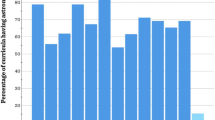Abstract
A questionnaire of 19 questions given to a total of 433 students in college preservice training for future high-school teachers showed that science and nonscience majors held a series of misconceptions on several central topics in basic astronomy.
Similar content being viewed by others
REFERENCES
Baxter, J. (1989). Children's understanding of familiar astronomical events. International Journal of Science Education 11: 302–313.
Bisard, W., Aron, R., Francek, M., and Nelson, B. (1994). Assessing selected physical science and Earth science misconceptions of middle school through university preservice teachers. Journal of College Science Teaching 24: 38–42.
Chaudury, R. (1998, September 21). Understanding the cause of seasons. Physics Learning Research List [On-line] Available E-mail: Physlrnr@listserv.boisestate.edu
Commission on Science and Technological Education (1992) Tomorrow, 98 Report from the Commission on Science and Technological Education, Ministry of Education, Jerusalem.
Dana, T., Campbell, L., and Lunetta, V. (1997). Theoretical bases for reform of science teacher education. The Elementary School Journal 97: 419–432.
Johns, K. (1984).Wanted: Money and time for science. School Science and Mathematics 84: 271–276.
Jones, B., Lynch, P., and Reesink, C. (1987). Children's conceptions of the Earth, Sun and Moon. International Journal of Science Education 9: 43–53.
Kikas, E. (1998). The impact of teaching on students' definitions and explanations of astronomical phenomena. Learning and Instruction 8: 439–454.
Klein, C. (1982). Children's concepts of the Earth and the Sun: A cross-cultural study. Science Education 65: 95–107.
Laws, P. (1997). Millikan Lecture 1996: Promoting active learning based on physics education research in introductory physics courses. American Journal of Physics 65: 14–21.
Lightman, A., and Sadler, P. (1993). Teacher predictions versus actual student gains. The Physics Teacher 31: 162–167.
Nussbaum, J. (1979). Children's conceptions of the Earth as a cosmic body: A cross-age study. Science Education 63: 83–93.
Nussbaum, J., and Novak, J. (1976). An assessment of children's concepts of the Earth utilizing structure interviews. Science Education 60: 535–550.
Radford, D. (1998). Transferring theory into practice: A model for professional development for science education reform. Journal of Research in Science Teaching 35: 73–88.
Sharp, J. (1996). Children's astronomical beliefs: A preliminary study of year 6 children in south-west England. International Journal of Science Education 18: 685–712.
Sneider, C., and Pulos, S. (1983). Children's cosmographies: Understanding the Earth shape and gravity. Science Education 67: 205–221.
Stronck, D. (1986). Trends in teachers' recommendations for changing elementary and junior-high school science programs. Journal of Research in Science Teaching 23: 201–207.
Trumper, R. (2000). University students' conceptions of basic astronomy concepts. Physics Education 35: 9–15.
Vosniadou, S. (1992). Knowledge acquisition and conceptual change. Applied Psychology 41: 347–357.
Vosniadou, S., and Brewer, W. (1992). Mental models of the Earth: A study of conceptual change in childhood. Cognitive Psychology 24: 535–585.
Vosniadou, S., and Brewer, W. (1994). Mental models of the day/night cycle. Cognitive Science 18: 123–183.
Wallace, J., and Louden, W. (1992). Science teaching and teachers' knowledge: Prospects for reform of elementary classrooms. Science Education 76: 507–521.
Yager, R., Lutz, M., and Craven J., III. (1996). Donational standards indicate the need for reform in science teacher education? Journal of Science Teacher Education 7: 85–94.
Zeilik, M., and Bisard, W. (2000). Conceptual change in introductory-level astronomy courses. Journal of College Science Teaching 29: 229–232.
Zeilik, M., Schau, C., and Mattern, N. (1998). Misconceptions and their change in university-level astronomy courses. The Physics Teacher 36: 104–107.
Author information
Authors and Affiliations
Rights and permissions
About this article
Cite this article
Trumper, R. A Cross-College Age Study of Science and Nonscience Students' Conceptions of Basic Astronomy Concepts in Preservice Training for High-School Teachers. Journal of Science Education and Technology 10, 189–195 (2001). https://doi.org/10.1023/A:1009477316035
Issue Date:
DOI: https://doi.org/10.1023/A:1009477316035




